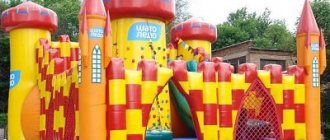Having turned their feet to industrial mountaineering, electricians, painters or installers not only enjoy extreme sports, but also receive a good reward for it. Washing windows and facades of high-rise buildings, installing advertising or clearing the roof of snow is not the entire list of tasks assigned to brave industrialists.
After all, you have to work at such altitudes that make the average citizen feel dizzy and nauseous (and add here sudden precipitation or gusty winds). It is foolish to believe that it is enough for an industrial climber not to suffer from acrophobia.
Note! Without such qualities as endurance, quick reaction, physical fitness and the presence of special equipment, there is nothing to do at altitude.
Profession industrial climber
Having appeared at the beginning of the twentieth century, industrial mountaineering practically did not develop. The profession became in demand later, when new technologies for construction and repair of buildings and structures were mastered.
The profession of an industrial climber involves performing high-altitude work at industrial and other facilities using special technology. The climbers are raised/descended to the place of work using a rope or other climbing methods of transportation and belaying.
Armed with equipment, professionals perform tasks of any complexity that cannot be accomplished in any other way (the customer no longer needs expensive rentals, installation of scaffolding, use of construction mechanisms and aerial platforms, as well as stopping production). Yes, working at heights is not cheap, however, it is more profitable than renting complex equipment.
A little history
The history of industrial mountaineering began in 1930. During the construction of the Hoover Dam (America), people were faced with a seemingly insoluble problem: cleaning and securing the canyon walls from moving rock failed, which was due to the features of the terrain.
However, the task was completed by professional miners, “armed” with rope and primitive mining equipment (they made depressions in the rock and placed dynamite in them). Unfortunately, due to insufficient mountaineering training, non-compliance with safety rules and lack of insurance, the operation led to a large number of casualties.
During the war with Nazi Germany (in besieged Leningrad), a group of Soviet climbers camouflaged the golden spiers, depriving the enemy of the opportunity to conduct aimed fire.
Industrial climbers are preparing the facade of the temple for painting at height.
In the 70s, reliable mountaineering equipment and modern rope appeared. Industrial mountaineering took off as a technology and as a profession in the early 1980s.
Who is this promalp?
An industrial climber or industrial climber is someone who performs high-altitude work where there is no support and no support is expected. Regardless of the type of work, the steeplejack uses the usual climbing equipment: ropes, helmet, safety system, descending devices and other components of labor safety.
The set of equipment and tools for industrial mountaineering is always the same. But the methods of use vary depending on the place and type of work. On average, industrial equipment costs 8 thousand rubles.
You need to know this! Working at height is always associated with a risk to life, so only trained people are allowed to do it.
How much do you pay for risk?
When determining prices, the rule works: a lot of risk - a lot of money. The promalp does not run on the ground or stand on scaffolding; it does its work suspended, moving along a rope. This is taken into account when determining the cost of services: the less work is done in one “window”, the higher the salary. Washing windows one line at a time - one price. Washing the glazing along the entire floor is another (this kind of work is more valuable).
There are standard works, the cost of which is easy to calculate, as well as complex ones, where the calculation is individual. Washing or painting is calculated based on the cost per 1 m².
Long sections - depending on the cost per linear meter and the complexity of the task (work on air ducts, drains, etc.). There is a calculation per unit (outer part of the air conditioner, antenna, etc.).
The cost of installing advertising and stretching a banner is determined by the complexity, volume of the structure, and the scale of the preparatory work.
Organizing a business in industrial mountaineering
The first thing you need to do to organize this unusual business is to register your business and select the appropriate OKVED code. The most suitable form is an individual entrepreneur (individual enterprise), since in this option the paperwork itself is much simpler, and taxes are deducted only from the company’s profits.
To obtain a license for work, complex permitting procedures from firefighters and the SES will not be required. You just need to buy equipment for industrial mountaineering and demonstrate it to an inspection organization. You will need special ropes, winches and carabiners for fastening. You also need to buy equipment in the form of a hanging chair and reliable insurance.
An important element of future success is the placement of advertising on Internet sites, which should have a clear focus on those who are potential customers for this type of service. You can also use cold calls in companies where there is a possible demand for high-altitude work using industrial mountaineering, placing your logo in directories of city organizations. Clients can be found at various industrial exhibitions for public utilities, and Internet spam can also be used.
The next step is to find real climbers with experience who know climbing equipment well. You can recruit a permanent team of workers, but this is not very profitable. After all, a true master of mountaineering will not agree to risk his health and life for less than 50 thousand rubles. It is more profitable to work under the scheme of one-time contracts, when the employee will have the status of a civilian employee and receive wages only for the time worked. For example, for a day of work it may be enough to pay 4,000 rubles. Under such conditions, especially young people and students from nearby educational institutions will be happy to come to work.
This type of cooperation is also good because it will be possible to hire people without local registration who come from afar. They will be satisfied with lower wages. Agree that it is more profitable to pay for the passage of a person from the outback and assign him a salary of 2,000 rubles per day than to pay a permanent worker 4,000 rubles for the same day worked. And don’t rack your brains over the question – where to find climbers? It is very likely that they themselves will come to get a job cleaning windows, all they need to do is do a good job advertising their business. To do this, you can give regular announcements about the recruitment of workers or simply go to the local climbing wall and talk with people “face to face.”
A good full-time employee may be lured by other companies by offering higher pay. Therefore, you cannot skimp when concluding fall insurance contracts with every person working at height. It’s not a bad idea to give industrial climbers the opportunity to work for daily cash if they want. Factoring payment schemes and guaranteed bonuses for complex work performed also retain employees well. These aspects of relations with employees are not at all expensive for the entrepreneur, but are a reliable mechanism for retaining the right people in the company.
Equipment and uniforms
Large and expensive equipment for industrial mountaineering is issued by the company, because it is not possible to store it at home.
Remember that a job cannot be done “perfectly” with a cheap tool, and do not be tempted by lucrative offers from little-known manufacturers (this also applies to equipment). You can choose equipment and uniforms in a ready-made kit or assemble them “for yourself.” The main components of the basic kit include:
- A safety system or harness is the most important component of safety equipment. Full belay devices, designed for industrial mountaineering, are kept at the work station and retained in the event of a fall.
- Self-insurance. A self-belay with two mustaches is connected to the harness. At its ends there are carabiners used for fastening and clips. Self-belaying can be done using a dynamic rope.
- At least two clamps. The first one provides insurance on a safety rope, moving along it. In case of a break, it protects against falling. The second (zhumar) is used for climbing a rope.
- Self-locking descender. Provides protection when rappelling. It is attached to the safety system with a carabiner. The combination of jumar+pedal+rope allows for lifting. If lifting is not needed, a figure-of-eight descender with a gripping unit is sufficient.
- At least 5 oval-shaped steel coupling carabiners.
- Helmet. It is better to refuse a motorcycle helmet or a construction helmet. An industrial climber needs a hard helmet with an adjustable suspension system that fits his head like a glove.
- Static rope with a diameter of 10–12 mm. The dynamic one is prone to stretching, which means it is not suitable. During work, at least two ropes are used (the number is determined by the assigned tasks). Gloves are required to prevent exposed skin from coming into contact with the rope. When descending with unprotected hands, a carpet burn may occur.
- To prevent the rope from fraying, special protection is used in places of kinks - protectors made of banner fabric, pipe scraps, and fire hoses.
- Auxiliary ropes for securing tools and lifting loads with a diameter of 4–8 mm. A static rope with a diameter of 6 mm is suitable for these purposes.
- A seat for the promalpa can be bought in a store, or you can build it from a piece of plywood with a thickness of 8 mm and rope. Prolonged work in a suspended position negatively affects blood circulation in the lower extremities. So without a seat - nowhere.
- Skyhooks (beak-shaped hooks) grab onto ridges and indentations to keep the climber locked in place or pulled to the side.
- Sucker. Used on smooth, often glass or tiled surfaces. Reliably fixes the climber.
Professional responsibilities of climbers
The industrial climber must follow the professional instructions:
- work only in conjunction, backing up a colleague;
- Before each exit to the site, check the condition of the equipment;
- carry a first aid kit, be able to provide first aid and, if necessary, evacuate a partner from the work area.
The work task of a climber is determined by the characteristics of a particular type of work. Upon arrival at the site, workers are obliged to:
- assess the condition of the object and scope of work;
- distribute tasks among workers;
- strengthen equipment;
- reassess the work task directly in the work area;
- do the work;
- evaluate the result for compliance with the task.
If a work task requires a long period of completion, after each work shift, climbers remove equipment and re-strengthen it before the next shift.
Risks and safety rules
Safety is the main requirement of industrial mountaineering. To avoid becoming a victim of an accident while performing work, check your equipment before each “outing”:
- Inspect all lines and seams on the harness.
- Go through the rope to promptly detect frayed, cut areas or places with worn braid.
- Check the integrity of descenders, belay devices and carabiners.
- Check the integrity of the teeth in the equipment parts that cling to the rope (if they are worn down, they must be replaced immediately).
- Inspect the seat (the rope is not frayed, the board is not cracked).
To choose a comfortable and safe place to work, look around in advance. If necessary (something may fall from above), block access to passers-by and close parking spaces.
If you have to work on a roof in winter or the roof is sloping, be sure to arrange insurance (PPE). Don't rely on guardrails. If you fall, you will fly over it or fall down with it.
Remember! Your life depends on the organization of insurance. Hang two ropes at once: descend one at a time, belay on the second (in industrial mountaineering, knots are tied at the ends of the ropes).
There must be at least two belay points (the places to which each rope is tied). Concrete buildings, strong railings, stairs and other reliable structures are suitable for these purposes.
Attention! The rope securing points should not be located in the same places. Please note that one point of insurance may fail.
There is nothing to do with an unprotected rope at height. Pointed pipes, the edge of the visor and other elements can leave you without insurance at any time.
Start and end of work
Finding himself suspended at a height of many meters, the climber experiences not the most pleasant moments in his life (however, few people admit this). To avoid putting your life at risk, before hanging over the edge of the roof, check:
- Is the rope tied well (if it is not, moving under the weight will ruin the climber’s comfortable position on the wall).
- Are the knots tied correctly (a carelessly or incorrectly tied knot can move or come undone).
- Location of protectors. Depending on how far the belay points are located, the belay system stretches under the worker's weight. Because of this, the protectors move off the rope and it rubs against the sharp edge of the roof. To prevent this from happening, attach protection. Projectors are also used for thin roofs that sag along the edges. An unsecured projector moves, damaging the roof, which is a recipe for injury.
- Is the length of the rope calculated correctly (an edge that is too long will lie on the ground and cling to rocks or bushes; a short rope will not reach the ground and you will not go down without the help of your comrades).
- Are all instruments ready for use? Everything you need should be at hand: tied to an auxiliary rope or lying/standing on the edge of the roof.
For what professions is it required?
Changing the infrastructure of large cities requires the construction of multi-storey buildings, which is why industrial mountaineering is a sought-after profession. At the same time, buildings become complex and dangerous.
Not only climbers need to use professional equipment, but also:
- electricians;
- plumbers;
- rescue workers;
- firefighters;
- athletes;
- diggers.
There are other professions that require equipment. It is essential for meteorologists who carry out research at any time. A set for industrial mountaineering is needed by geographers, speleologists, and cartographers.
Pros of work
Advantages of an extreme profession:
- high wages (quick earnings);
- convenient schedule;
- routine is eliminated due to the variety of objects and types of work;
- demand;
- a high level of physical activity allows you to keep yourself in good shape;
- officially employed industrial workers receive bonuses for “harmfulness,” night shifts, and winter work;
- opportunity for professional growth and learning new skills;
- You can work “in the wild”, providing individual services.
Market analysis
There is quite high competition in the market, but the lion's share of competitors are private owners. That is, usually these are workers who have previously worked at a construction site and have some experience in carrying out high-altitude work. Now they have bought a special kit and are offering services at the same prices they were charged at the construction site. These are quite low prices that clients are charged. But in most cases they get disastrous results without guarantees.
That is why the business is still promising in terms of organizing a profitable business. Large companies and small firms prefer to enter into long-term contracts for the provision of services with a guarantee. Therefore, in the legal sphere of business, competition is quite low and there is still room for new players.
True, they will have a hard time getting used to it. Industrial mountaineering is difficult to promote using traditional advertising methods. The maximum return comes only from direct contact with a potential client, defining his tasks, and conveying to him the benefits of cooperation with a specific company. Next, it is important to fulfill the order well so that word of mouth works. By the way, you shouldn’t limit your activities to your own city.
Minuses
Obvious disadvantages include:
- piecework wages, which sometimes have to be “knocked out” (even trusted customers fail);
- the need to work with unfamiliar partners (frequent grinding, etc.);
- the demand for freelancers depends on the season (you have to get sick, rest, and recover from injuries at your own expense);
- Experience and high-altitude license required;
- high danger (a mentally unstable person can cut the rope, a heavy object can fall from above, a strong wind can hit the wall, etc.);
- Not everyone can handle physically and psychologically hard work (it’s like professional sports with a high level of injuries and occupational diseases);
- There are really difficult shifts (you have to work continuously, 21 hours a day, if the order is urgent).
Costs and profits
According to rough estimates, the investment will amount to 570,000 rubles. The business requires significant labor costs, but the profit will be good for large orders. With a minimum monthly profit of 100,000 rubles, it is possible to recoup the investment in six months.
Start-up costs: approximate calculation for Moscow
| Expense item | Amount, ₽ |
| Business registration | 20’000 |
| Equipment | 500’000 |
| Unexpected expenses | 50’000 |
| Total | 570’000 |
Monthly costs
| Rent | 50’000 |
| Salary | 300’000 |
| Unexpected expenses | 70’000 |
| 20’000 | |
| Total | 440’000 |
How to get into the profession
Climbers are not always limited to overcoming natural obstacles created by nature on the way to the top. Many people come to high-altitude sports from high-altitude sports.
But more and more often, a question comes up on Internet forums: how can a person far from any construction skills become an industrial climber? Here is one of the answers: undergo training at the private educational institution "AVTODOR" (Moscow). Duration – from two weeks. Cost from 14 thousand rubles.
Any physically resilient person who does not have problems with the heart, psyche and blood vessels can become a professional.
How to get an industrial climber's license
The employee must have the following documents:
- certificate of professional qualification level;
- a qualification certificate of training, passing an exam in a licensed educational institution;
- certificate of testing knowledge of labor protection requirements;
- promalpa crust.
Only specialized schools of industrial climbers can train and examine.
Qualification categories of industrial climbers according to ETKS
The newly minted professional is assigned the 5th category. He is allowed to carry out painting, restoration and other work at heights.
A specialist of the 6th category (mandatory specialty - welder) is engaged in gas welding, plasma cutting, and carries out shotcrete with helicopter crews.
A 7th category specialist (secondary specialized education is required to work with instruments) works with complex equipment: radio range finders, electronic digital systems, etc.











